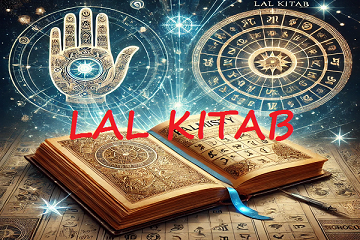Lal Kitab and Karma: The Interplay of Past, Present, and Future

The concept of karma, or the law of cause and effect, lies at the heart of many spiritual traditions. Lal Kitab, with its unique approach to astrology and remedies, deeply intertwines with the philosophy of karma, offering a profound understanding of how past actions shape our present and influence our future. Through its insightful interpretations and practical solutions, Lal Kitab provides a roadmap to navigate the karmic cycles of life.
Understanding Karma Through Lal Kitab
Karma, derived from the Sanskrit word meaning "action," refers to the spiritual principle that every action has a corresponding reaction. Lal Kitab takes this universal concept a step further by linking it to planetary positions in one’s horoscope. According to Lal Kitab, the planetary placements reflect the karmic debts and blessings carried from past lives.
These placements not only indicate the challenges and opportunities an individual may face but also suggest remedies to balance and harmonize these influences. By addressing karmic imbalances, Lal Kitab aims to create a path of growth, understanding, and self-realization.
The Role of Planets in Karmic Patterns
Each planet in Lal Kitab symbolizes specific karmic energies. Here’s how they are interpreted:
- Sun: Represents ego, authority, and leadership. It reflects the karma of self-identity and power dynamics.
- Moon: Symbolizes emotions and the subconscious mind. It relates to past emotional patterns and nurturing experiences.
- Mars: Governs energy, aggression, and courage. It indicates karmic lessons related to assertiveness and conflict resolution.
- Mercury: Represents intellect and communication. It reveals karma linked to learning, adaptability, and relationships.
- Jupiter: Signifies wisdom, prosperity, and spiritual growth. It reflects the karmic rewards or debts in higher knowledge and ethics.
- Venus: Embodies love, beauty, and harmony. It relates to karmic experiences in relationships and creative expression.
- Saturn: The planet of discipline and responsibility. It highlights karmic tests of patience, endurance, and maturity.
- Rahu and Ketu: Represent the karmic nodes of the Moon, indicating unresolved desires and spiritual growth areas.
Lal Kitab Remedies as Karmic Balancers
The remedies in Lal Kitab are designed to address and balance the karmic influences of the planets. By performing these remedies, individuals can mitigate negative karma, enhance positive energies, and create a harmonious life. Here are some examples:
- Charity: Donating food, clothes, or money is considered a powerful way to cleanse karmic debts and generate positive karma.
- Acts of Service: Helping others, especially those in need, aligns with the principle of selflessness and reduces ego-driven karma.
- Symbolic Actions: Actions like offering water to the Sun or feeding animals carry symbolic meanings that harmonize planetary energies.
- Personal Discipline: Practicing humility, kindness, and mindfulness helps break negative karmic cycles and foster spiritual growth.
Karmic Cycles and Free Will
One of the profound teachings of Lal Kitab is the interplay between karmic cycles and free will. While planetary positions indicate karmic influences, they do not completely determine an individual’s destiny. Lal Kitab emphasizes the role of free will in shaping one’s life. By actively engaging with the remedies and making conscious choices, individuals can transform their circumstances and create positive outcomes.
The Transformative Journey of Self-Reflection
Lal Kitab encourages self-reflection as a key component of understanding and resolving karmic patterns. By analyzing one’s horoscope and identifying areas of imbalance, individuals can gain deeper insights into their life’s purpose and challenges. This process fosters self-awareness and a greater understanding of how actions influence not only their own lives but also the lives of others.
Practical Steps to Align with Positive Karma
To align with positive karma and create a harmonious life, consider the following steps inspired by Lal Kitab:
- Engage in daily acts of kindness and generosity to generate good karma.
- Practice forgiveness, both for yourself and others, to release karmic burdens.
- Embrace personal responsibility for your actions and strive for ethical behavior.
- Perform Lal Kitab remedies with sincerity and a clear intention.
- Develop a regular practice of meditation or self-reflection to connect with your inner self.
Conclusion: Embracing the Wisdom of Lal Kitab and Karma
Lal Kitab offers a unique perspective on the law of karma, providing practical tools and insights to navigate life’s challenges and opportunities. By understanding the karmic influences reflected in planetary positions and actively engaging with the remedies, individuals can transform their lives, foster personal growth, and create a positive ripple effect in the world.
Whether you are seeking to resolve specific issues, deepen your spiritual connection, or understand your life’s purpose, Lal Kitab serves as a guiding light. Embrace its wisdom and embark on a transformative journey of karma and self-discovery.

